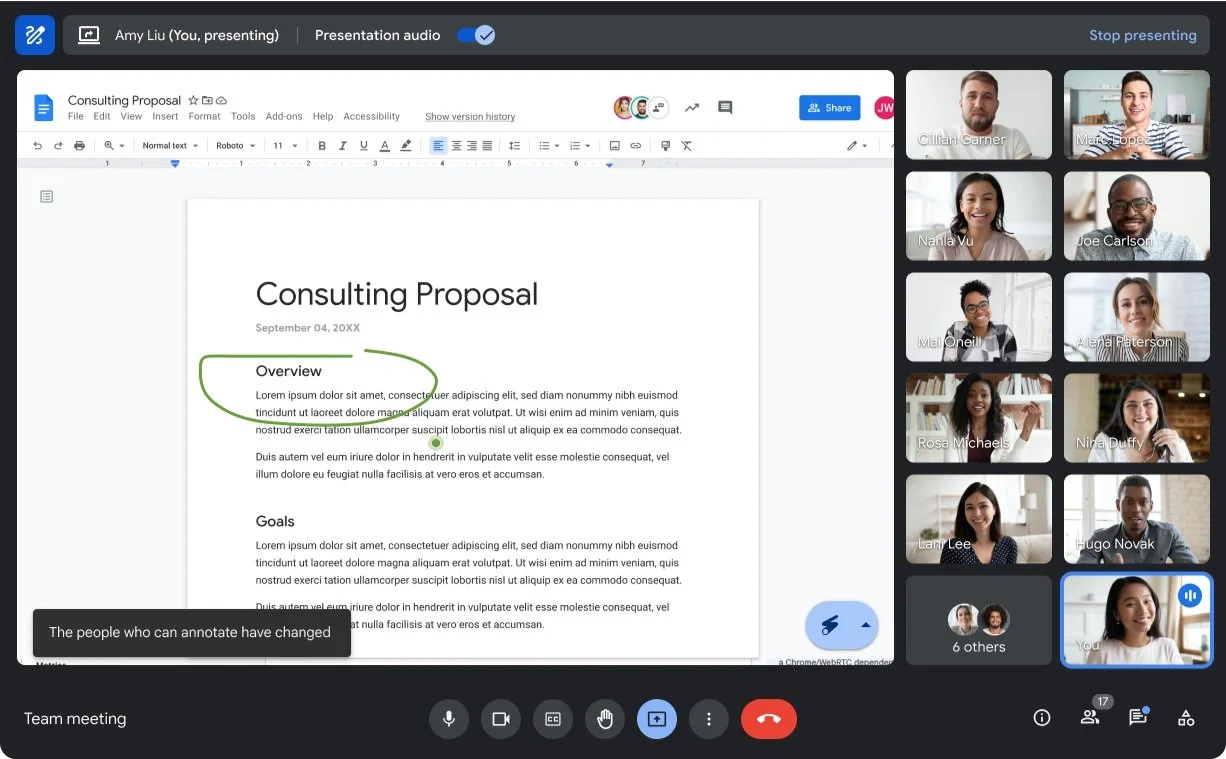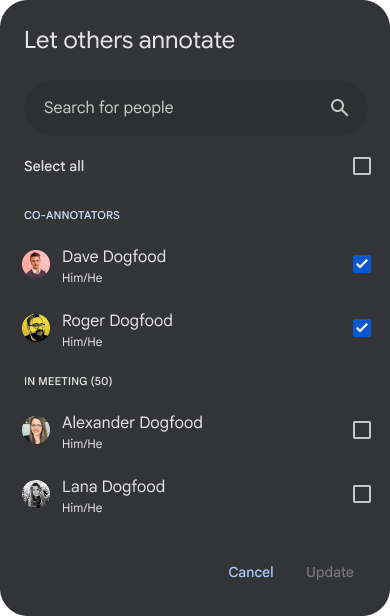Introduction
Co-annotations in Meet
Google Meet
Google Meet is a video conferencing platform that allows users to hold online meetings, video calls, and conferences. It features high-quality video and audio, screen sharing, meeting scheduling, and integration with Google Workspace.
Google Meet targets a wide range customer base, including businesses of all sizes, educational institutions, personal use, and non-profit organizations.
What are annotations?
🖥️
Annotations enable real-time drawing and highlighting on shared screens, making meetings more interactive.
Problem
Design challenge
Project Goals
This case study details my end-to-end design journey for the follow up to GA co-annotations feature in Google Meet. By enabling presenters to add multiple annotators, this enhancement directly addressed user pain points and resulted in a more intuitive and collaborative experience for real-time annotation during meetings.Team
Lead UX interaction designer
Product manager
Software engineer manager
Software engineer
Tools
Figma
Google Workspace
Material Design 3
Workspace Design system
My Role
UX Designer
Designed for larger meetings, this update streamlines the presenter's ability to choose a larger group of participants to annotate on screen. The new modal makes this selection process easier.
Although Google Meet provides two methods for presenters to add co-annotators—via the people panel and people tile overflow menus—research reveals a lack of discoverability.
This concealment in the user interface is preventing presenters from effectively leveraging the co-annotation feature, hindering seamless collaborative presentations.
What do we want to achieve?
Increase discoverability of co-annotationsWith a current low discoverability rate, we expect to increase visibility through upcoming updates, including a new entry point.
Process
Existing entry points to add co-annotators
The second existing entry point for selecting co-annotators is located within the people panel
2. People panel
Presenter clicks the people panel
Video tile
Meet currently has two entry points to assign co-annotators one of which is directly from a participant's video tile
Presenter hovers over video tile
Educators/trainers
Insights
People panel in Meet
Low fidelity
✏️
Users can utilize a variety of tools, such as pens and text boxes, to visually communicate during presentations.
Collaborative teams
Google Drive
I explored bulk selection models to enhance the annotations feature and improve discoverability through a new entry point.
Timeline
July - August 2024
Shipped
December 2024
Annotation Users
Researching current multi-select models at Google
Design 1
Design 2
Design 3
Presenter clicks ‘Add as co-annotator’
Presenter clicks ‘Add as co-annotator’
Breakout rooms in Meet
Presenters
Google Chat
Google Calendar
👥
This feature enhances engagement and clarity, transforming standard screen sharing into a collaborative experience with co-annotators.
Enable adding co-annotators in bulkOption 1
Results
Design proposal
Solution
High fidelity
Overview of the high fidelity iterations for co-annotator selection
Chosen design solution for bulk selection
Number of annotators
Number of participants
Dual list view
To increase discoverability of co-annotation we will introduce an entry point in the tool menu
The presenter checks off select all box to allow all contributors in meeting to annotate and clicks Update
The presenter will be notified with a message that changes have been made
Key takeaways
Bulk select
Collapsible
Option 3
Launched
What’s next?
Moving forward, we're excited to explore promising avenues for enhancing this feature, specifically focusing on automating co-annotator assignments, particularly within smaller meetings and for pre-assigned co-hosts.
This targeted approach holds strong potential to streamline collaboration and ultimately improve the feature's visibility and utility for our users.
Following initial feedback and a design critique session with fellow designers, I focused on the exploration of visual design options for Design 2.
MVP design pivot
Final spec
User flow
Search for participants
Large meetings
Option 2
While collaborating closely with our engineering team, we identified technical limitations and timeline constraints for our proposed design.
To ensure a successful MVP launch within the given timeframe, we made a strategic decision to iterate the design. This involved scoping down to a single-list implementation, which allowed us to deliver core functionality to users without compromising the launch schedule.
The initial launch of this feature did yield a boost in discoverability as we had hoped for and provided invaluable insights as an early experimental step in shaping our product direction.
We learned a great deal about user behavior and feature interaction, which will directly inform our next iterations.































